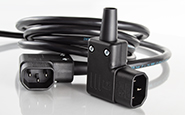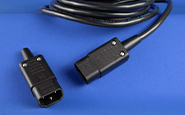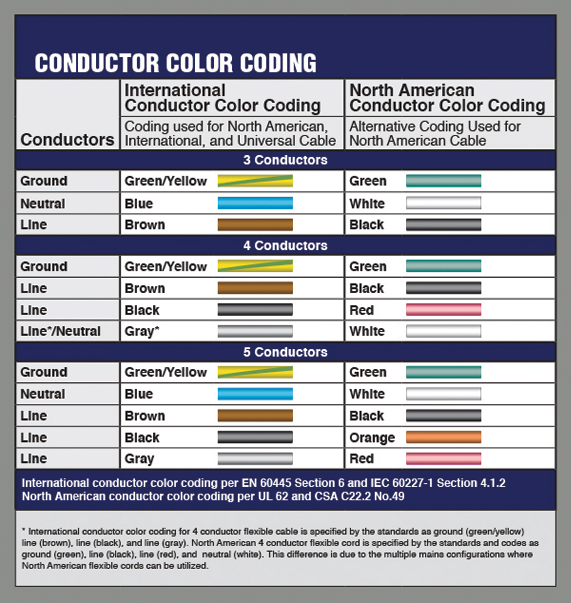Comparing and Contrasting North American and International Cable
Cable completes the electrical circuit from the power source to the equipment. The end destination of the product will determine the type of cable that will need to be used. Two of the widely used types are North American and international approved cable. While the two cable types may be similar in appearance, there are a number of important differences.
Sizing
North American Cable
The sizing for North American cable is noted by AWG. The gauge uses an inverse relationship to the size, so the larger the number, the smaller the cable. For example, a small gauge North American cable with three conductors might be 3 x 18 AWG (or 18/3 AWG). A large gauge cable might be 3 x 10 AWG (10/3 AWG).
International Cable
International cable is sized in square millimeters. This measurement comes from the diameter taken from the circumference of a cross section of each conductor. The size is expressed in millimeter-squared (mm2). Size increments are designated within the standards and vary as the cable size increases.
Cable Types
North American Cable
There are a variety of North American cable types with letter designations indicating different kinds. The types of North American cable offered by Interpower include:
PVC Cable
- SJT
Junior hard service, thermoplastic-insulated conductors and jacket. - SJTO
Same as SJT, but oil-resistant thermoplastic outer jacket. - SJTOW
Same as SJTO except weather-resistant rated. - SJTW
Hard-usage thermoplastic or rubber-insulated conductors and overall thermoplastic jacket; weather-resistant for outdoor use. - SVT
Thermoplastic-insulated vacuum cleaner cord, with or without third conductor for grounding purposes. - SPT-2
Parallel jacketed thermoplastic cable with heavier construction than SPT-1. - ST
Hard service cord with all thermoplastic construction. - STO
Same as ST, but with oil-resistant thermoplastic outer jacket. - STOW
Same as STO, but weather-resistant rated.
Thermoset Cable
- SO
Extra hard service cord, thermoset-insulated conductors and thermoset oil-resistant jacket. - SOW
Same as SO except weather-resistant rated. - SOOW
Same as SO except both conductor insulation and jacket are oil-resistant and weather-resistant rated.
TPE Cable
- SEOW
Extra hard service cord, thermoplastic elastomer conductor insulation and jacket with oil-resistant jacket and weather-resistant rated. - SEOW
Extra hard service cord, thermoplastic elastomer conductor insulation and jacket with oil-resistant jacket and weather-resistant rated. - SJEOW
Hard service cord, thermoplastic elastomer insulation and jacket and weather-resistant rated.
Notes on the Above Cable Designations:
- Definitions of cable designations are derived from UL’s designation scheme as defined in the National Electric Code (NEC)—NFPA-70.
- When only one “O” appears in a classification (e.g. SJEOW), only the outer jacket material is oil-resistant. If two “O’s” are in the classification (e.g. SJEOOW), the insulation covering the conductors and the outer jacket insulation are both oil-resistant.
- CSA does not recognize the letter “E” used by UL to designate thermoplastic elastomer. CSA classifies these cable types using the PVC classification designations with a “TPE” suffix. For example, the designation SJTW (TPE) is used in Canada and SJEW is used in the United States.
See more information on North American cable types.
International Cable
A series of numbers and letters indicate the jacket material, ratings, and size of the cable. The types of international cable offered by Interpower include:
H03VV-F
H05V-K
H05RN-F
H05VV-F
H07V-K
H07RN-F
RVV
VCTF
S05VC4VF
The Harmonized Wire Coding System chart gives more explanation about what the various letter and number designations mean.
Some Notes on International Cable:
- International cable needs to be manufactured in accordance with EN (European Norm) 50525 cable standards. These are European standards accepted by member countries of CENELEC (European Committee for Electrotechnical Standardization), an organization which has agreed upon formalized methods of construction and testing for common products.
- Manufacturers from countries outside of the CENELEC group can be awarded approval to make international cable. They need to have approvals from at least one of the European testing agencies in accordance with the EN 50525 standards. When listing a cable type, e.g. H05VV-F, the “H” means it meets the harmonized cable standard (EN 50525), except that it is manufactured outside the CENELEC group of countries.
- Some international cable carries a special marking—the <HAR> mark—but not all international cable does. Depending on where the cable manufacturer is located, determines whether the <HAR> mark can be put on the cable itself. The <HAR> mark is a common marking that can only be used on cable manufactured by signatory members of CENELEC.
- International cable needs to be manufactured in accordance with the IEC (International Electrotechnical Commission) cable standards, such as IEC 60227, and may also need to follow other country-specific cable standards as well, depending on the country the cable will be used in.
- International cable (depending on approvals) can be used in Europe and in other countries throughout the world—except in North America.
Conductor Color Coding
Marking of the conductors within the cable defines which conductor is ground, neutral, and line. There are different color codes for North American and international cable. For North American 3-wire cable, there are two color codes that are accepted and most widely used. The combination of green (ground), white (neutral) and black (line) is the North American cable color code. The international color code combination of green/yellow (ground), light blue (neutral), and brown (line) is also an accepted color code for North American 3-wire cable.
See the Conductor Color Coding Chart
Testing and Certification Requirements
North American Cable
Interpower North American cable meets the UL and CSA standards.
International Cable
Interpower international cable is tested and certified according to the international standards.
Interpower Manufactured Cable
Interpower now manufactures both North American and international cable. For more information on the complete line of North American and international cable offered by Interpower, see North American and International Cable. See also the Featured Product pages on North American Cable and on Interpower International Cable.
Additional Resources
Interpower offers free technical support. For further assistance, please see Interpower’s contact information below.







